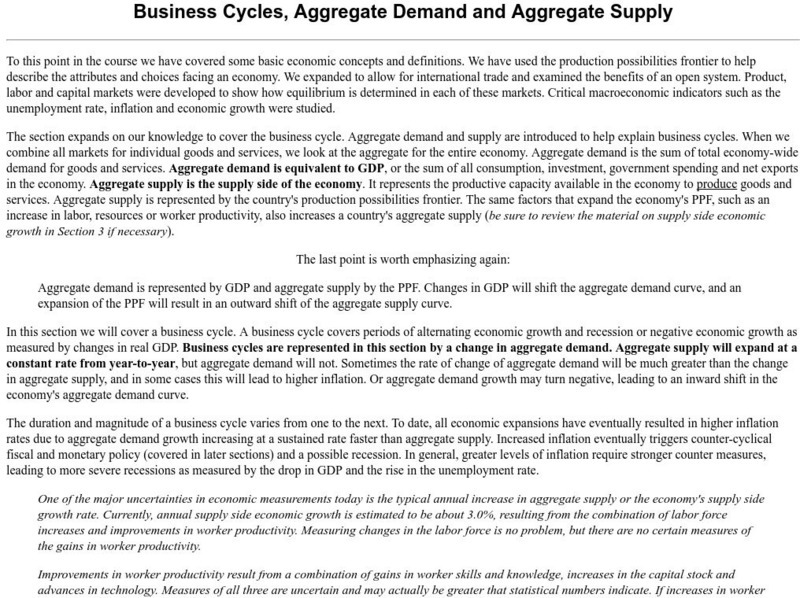Hi, what do you want to do?
Khan Academy
Khan Academy: How the Ad/as Model Incorporates Growth, Unemployment, Inflation
The aggregate demand/aggregate supply, or AD/AS, model is one of the fundamental tools in economics because it provides an overall framework for bringing economic factors together in one diagram. These factors include economic growth,...
Khan Academy
Khan Academy: Law of Supply
If the price of something goes up, companies are willing (and able) to produce more of it.
Council for Economic Education
Econ Ed Link: What Do People Want to Wear?
To stay in business, fashion merchandisers must be able to anticipate what consumers want. By looking at different retail websites, learners will look to anticipate what consumers are demanding. Students will then go through the market...
Texas Education Agency
Texas Gateway: Ap Macroeconomics: Chapter 8: The Confusion Over Inflation
By the end of this section, you will be able to do the following: Explain how inflation can cause redistribution of purchasing power, Identify ways inflation can blur the perception of supply and demand, and Explain the economic benefits...
Massachusetts Institute of Technology
Mit: Open Course Ware: Labor Economics and Public Policy
An introductory course in labor economics from MIT. Emphasizes applied microeconomics and empirical analysis. Includes suggested readings, assignments, and exams.
University of Nebraska Omaha
Ecedweb: Explorations in Economic Supply, Part I
Examines how supply relates to economic decision making. Using the example of purchasing blue jeans, students take the role of producer to determine how many blue jeans they would supply to the market. Includes links and discussion...
Khan Academy
Khan Academy: Keynes' Law and Say's Law in the Ad/as Model
Compare Keynes's and Say's law in the context of aggregate supply and demand.
Council for Economic Education
Econ Ed Link: Babysitter Shortage in Washington, d.c.
What is responsible for the shortage of babysitters in Washington, DC? Identify the parts of the article which indicate a decrease in supply and an increase in demand.
Council for Economic Education
Econ Ed Link: Tapped Dry: How Do You Solve a Water Shortage?
Economists do not operate in a vacuum. If an economist is going to suggest that the price of a good needs to be increased, he or she needs to consider who will bear the increase in costs. Will the costs be distributed equally or will one...
Khan Academy
Khan Academy: Lesson Summary: Banking and the Expansion of the Money Supply
This lesson summary from Khan Academy is intended for students who are taking the AP Macroeconomics course. In this lesson summary will review key terms and calculations related to fractional reserve banking, required reserves, excess...
Khan Academy
Khan Academy: Shifts in Aggregate Demand
Aggregate demand is made up of four components: consumption spending, investment spending, government spending, and spending on exports minus imports. Increasing or decreasing any of these components create shifts the AD curve.
Khan Academy
Khan Academy: Elasticity in the Long Run and Short Run
The elasticity of supply or demand can vary based on the length of time you care about. This resource is designed for students who are taking a college-level microeconomics course.
Council for Economic Education
Econ Ed Link: Collecting for Fun . . . And Profit?
Art, baseball cards, coins, comic books, dolls, jewelry and stamps are just a few examples of the many things people collect. While some people collect for fun, others hope to profit. In this lesson, students explore how supply and...
Council for Economic Education
Econ Ed Link: If I Ran the Zoo Economics and Literature
Welcome to the Zoo! In this two-day lesson you will use Dr. Seuss' If I Ran The Zoo book to introduce the economic concepts to your students. You will also get the chance to use actual zoo criteria to help a zoo "choose" new animals.
Khan Academy
Khan Academy: Price Ceilings and Price Floors
This article discusses how quantity demanded react to artificial constraints on price.
Council for Economic Education
Econ Ed Link: Traditional Economies and the Inuit
The Inuit people of northern Canada provide an example of a traditional economy. For thousands of years, Inuit parents have taught their children the survival skills needed to survive in the Arctic Circle's severe climate. Students will...
Council for Economic Education
Econ Ed Link: Wages and Me
Students explore the reasons for differences in the wages for several occupations. Then students are guided through the Bureau of Labor Statistics website to find information about their potential careers and wage rates nationally and in...
Council for Economic Education
Econ Ed Link: Exchange Rates and Exchange: How Money Affects Trade
Young scholars learn how currency values are set by supply and demand, and how changes in the value of currency affect international trade. Students then find the value of the Brazilian Real in 2000 and 2002, determine whether the...
University of Colorado
University of Colorado: Aggregate Supply and Demand
This site is a short lesson on business cycles, aggregate demand, and aggregate supply. It has some good explanations of the terms.
Other
Economic Glossarama: Supply
This economic glossary provides a definition of supply, and 2000 other economic terms and concepts.
Khan Academy
Khan Academy: Law of Demand
If the price of something goes up, people are going to buy less of it.
Curated OER
Market Price: Supply & Demand
This site from Wood Green School Witney explains market price. It includes graphs related to supply and demand. The explanation deals with basic economic terms establishing equilibrium market price. The site is theoretical in nature and...
University of Colorado
University of Colorado: Demand, Supply, and Markets
This site discusses in great detail the differences between demand, supply, and markets. Useful economic terminology is identified in bold.
Council for Economic Education
Econ Ed Link: Marketplace: Iraq's Supply and Demand
For this lesson, young scholars listen to an audio file about how the growing demand for workers in Iraq in May 2004 affected the job market, and how the effects of low growth in the supply of workers shaped companies' hiring practices...


















